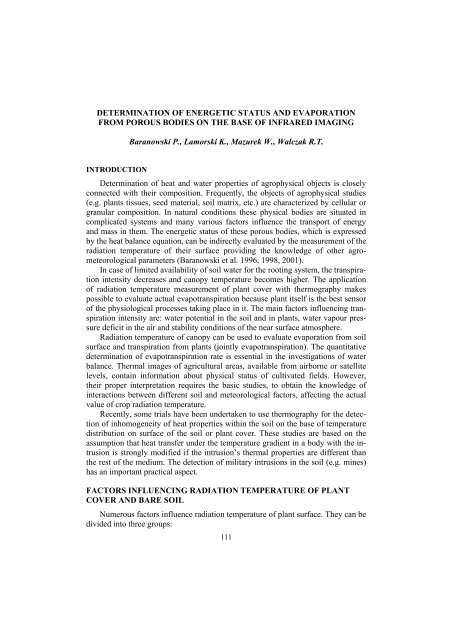soil - Lublin
soil - Lublin
soil - Lublin
You also want an ePaper? Increase the reach of your titles
YUMPU automatically turns print PDFs into web optimized ePapers that Google loves.
DETERMINATION OF ENERGETIC STATUS AND EVAPORATION<br />
FROM POROUS BODIES ON THE BASE OF INFRARED IMAGING<br />
Baranowski P., Lamorski K., Mazurek W., Walczak R.T.<br />
INTRODUCTION<br />
Determination of heat and water properties of agrophysical objects is closely<br />
connected with their composition. Frequently, the objects of agrophysical studies<br />
(e.g. plants tissues, seed material, <strong>soil</strong> matrix, etc.) are characterized by cellular or<br />
granular composition. In natural conditions these physical bodies are situated in<br />
complicated systems and many various factors influence the transport of energy<br />
and mass in them. The energetic status of these porous bodies, which is expressed<br />
by the heat balance equation, can be indirectly evaluated by the measurement of the<br />
radiation temperature of their surface providing the knowledge of other agrometeorological<br />
parameters (Baranowski et al. 1996, 1998, 2001).<br />
In case of limited availability of <strong>soil</strong> water for the rooting system, the transpiration<br />
intensity decreases and canopy temperature becomes higher. The application<br />
of radiation temperature measurement of plant cover with thermography makes<br />
possible to evaluate actual evapotranspiration because plant itself is the best sensor<br />
of the physiological processes taking place in it. The main factors influencing transpiration<br />
intensity are: water potential in the <strong>soil</strong> and in plants, water vapour pressure<br />
deficit in the air and stability conditions of the near surface atmosphere.<br />
Radiation temperature of canopy can be used to evaluate evaporation from <strong>soil</strong><br />
surface and transpiration from plants (jointly evapotranspiration). The quantitative<br />
determination of evapotranspiration rate is essential in the investigations of water<br />
balance. Thermal images of agricultural areas, available from airborne or satellite<br />
levels, contain information about physical status of cultivated fields. However,<br />
their proper interpretation requires the basic studies, to obtain the knowledge of<br />
interactions between different <strong>soil</strong> and meteorological factors, affecting the actual<br />
value of crop radiation temperature.<br />
Recently, some trials have been undertaken to use thermography for the detection<br />
of inhomogeneity of heat properties within the <strong>soil</strong> on the base of temperature<br />
distribution on surface of the <strong>soil</strong> or plant cover. These studies are based on the<br />
assumption that heat transfer under the temperature gradient in a body with the intrusion<br />
is strongly modified if the intrusion’s thermal properties are different than<br />
the rest of the medium. The detection of military intrusions in the <strong>soil</strong> (e.g. mines)<br />
has an important practical aspect.<br />
FACTORS INFLUENCING RADIATION TEMPERATURE OF PLANT<br />
COVER AND BARE SOIL<br />
Numerous factors influence radiation temperature of plant surface. They can be<br />
divided into three groups:<br />
111

















